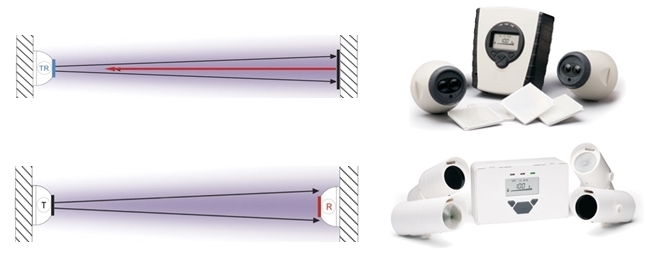
When expressing the beam type smoke detectors, "linear” definition is used in Turkish. This expression is due to the fact that the beam, which can also be referred to as the light beam, is in a direction after it is generated.
The beam type smoke detectors detect the rate of beam interruption sent between a light beam generating transmitter unit and the beam receiving unit. When this rate of interruption reaches the alarm threshold level determined according to the percentage of interruption, the detectors switch to the alarm state. Although the protection distances (such as 50m, 100m, 120m, 150m) vary according to the manufacturers and models, the placement criteria determined by the standards are taken into account in practice.
In terms of operating principles, they are basically examined under two sub-headings:
The reflective beam type smoke detectors are the type where the transmitter and receiver unit are on a single unit on the same side. The light beam generated by the transmitter is reflected back from the prismatic reflector, which is positioned linearly at a specific distance. The returning light beam reaches the receiving unit. Alarm is generated depending on the percentage of interruption of the light beam generated and located on the route to the receiver by smoke. There is no requirement for installation on the reflector side. Their assembly and installation are relatively more cost-efficient and easier.
The reflective types are also divided into two categories among themselves;
The standard beam type smoke detectors shall be placed in accordance with the standards in the area where they are used and shall be fixed and installed. After the installation, they are fixed after adjusting the direction of the light beam with the adjusting nuts.
The motorized reflective beam type smoke detectors are fixed by the same method. However, since it has a motorized mechanism, the control unit focuses itself instantly and automatically on the right axis in case of sliding in the direction of the beam for various reasons.
The working principle in the receiver/transmitter beam type smoke detectors is similar to the principle of the reflective detectors, but the basic difference is the mutual positioning of the transmitter and receiver units in linear alignment. Thus, when the light beam first reaches the transmitter unit opposite the receiver unit, verification is made and the beam reaches the receiver unit by being amplified again. Resistance is provided against false alarm conditions. More stable operation provides more stable protection. There is also a need for installation for energy and monitoring on the reflector side.
The receiver/transmitter type beam type smoke detectors are also divided into two categories between themselves;
The new generation of smoke detectors, which are capable of applying double beam (UV/IR) and multi-transmitter units, have a wide range of applications since they are resistant to false alarm conditions. The standard beam is the infrared (IR-Infrared) beam. Both infrared (IR-Infrared) and ultraviolet (UV-Ultraviolet) beams are used in the double beam type detectors.
These types of detectors, which are also CMOS imaging sensors, provide much more effective detection with CMOS sensors and UV/IR dual beam than the point and standard beam type smoke detectors, especially in high volume areas. The CMOS imaging technology provides 3D volumetric protection by placing more than one receiver in the environment at various angles, while preventing adjustment defects due to the movements of the building. The UV/IR double wavelength beam type detection technology eliminates the risk of false alarms by separating smoke and dust particles.